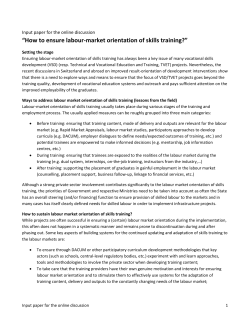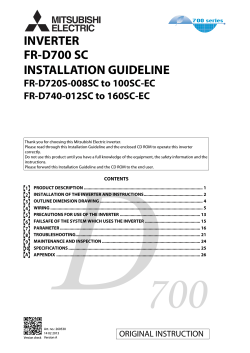
How to implement inverter variable speed drives
How to implement inverter variable speed drives Reducing the speed of a motor – even by a small amount – can save energy and money. Inverter variable speed drives (VSDs) control the speed of electric motors and can cut energy use by half. The business case The technology The cost of installing a VSD depends on its size and the type of automatic controls provided. Inverter variable speed drives alter the speed of an AC induction motor by varying the electrical frequency. As an example, though, a VSD used with a fan powered by a 5.5kW electric motor would cost around £1,500 to install, excluding any automatic controls. If the speed of the motor could be reduced by 20%, you’d save around 50% of the energy. They can be controlled manually as needed or left at a constant, reduced speed If the fan operated for 80hrs/week, that would be a saving of £695 a year, based on electricity at 7.9p/kWh, including Climate Change Levy. The VSD would pay for itself in just over two years. Another option is to use a sensor to adjust the speed automatically, based on temperature, pressure or flow. This is ideal for situations where demand varies. Applications How much a VSD could save you depends on the load on the motor. Use the table below and the list of applications as a guide to whether a VSD could be useful in your operation. Load characteristic Variable torque Constant torque Constant power Typical applications Centrifugal fans and pumps Positive displacement air compressors, conveyors, agitators, crushers and surface grinders Machine tools and centre winders Potential for saving energy Great potential, and the most common use of VSDs Limited potential No potential How to implement inverter variable speed drives 2 The following applications tend to benefit most from VSDs. • Extraction fans in drying areas, where motorised dampers maintain pressure balance. • Centrifugal fans and pumps that don’t need to run at full capacity all the time, such as: • Combustion air fans on large burners, where motorised dampers adjust the air to fuel ratio. • Ventilation fans for areas where occupancy varies, as in offices and lecture theatres. VSDs can vary the ventilation rate based on demand. This can be measured using an air quality sensor. • Heating and chilled water circulation pumps. VSDs can reduce circulation rates in mild weather. This can be measured using flow and return water temperature sensors. Specification checklist The following table outlines the main points to discuss with your supplier when deciding on the right variable speed drive. • Processes or systems driven by a centrifugal pump or fan, but where dampers and valves control the flow. In these cases, a VSD can be an energy-efficient alternative to the control damper or valve, which should be removed or set at permanently open. Examples include: Table 1 Specification checklist Considerations Comments Motor and VSD maximum power capability Motor power rated in kW. Full load current and starting current expressed in amps. Variable or constant torque application See Applications section. VSD electromagnetic compatibility (EMC) VSDs may produce electromagnetic interference that can affect radio and telecomms equipment. Specialist advice can help you avoid problems later on. Manual or automatic control of drive speed Consider using manual control for constant reduced speed applications. Use automatic control for situations with varying demand. Ensure the VSD has input/output capability to monitor the control system. Control parameters (for automatic control only) The sensor should measure the actual load – flow, pressure and so on. How to implement inverter variable speed drives 3 Commissioning procedure Finding a supplier Choosing, installing and commissioning a VSD is a job for a specialist, and you should always get advice from the manufacturer. Variable speed drives come under the Government’s Enhanced Capital Allowances scheme. You can see a list of ECA approved VSD manufacturers at www.eca.gov.uk The installation and commissioning engineer will set and calibrate the control system so that the VSD matches the requirements of the process or equipment. Correct set-up is essential for maximum savings. VSDs should always be fitted by a good electrical contractor. Electrical checks need to comply with the latest BS7671 IEE electrical wiring regulations. Common problems Most inverter VSDs are trouble–free, but it’s wise to consider these potential problems at the design and specification stage: • The VSD must match the torque of the load. Check with the manufacturer. • Inverter VSDs may produce electromagnetic interference that can affect radio and telecomms equipment. Most manufacturers incorporate special filters, but you should take care with the layout, keeping the length of wiring to a minimum and ensuring all motor-side cables have earth screens. • Running a motor at lower speeds reduces the cooling effectiveness of its fan. This is rarely a problem provided the motor operates at 50% or above of its full speed. Get advice from the manufacturer. Legal information
© Copyright 2025





















